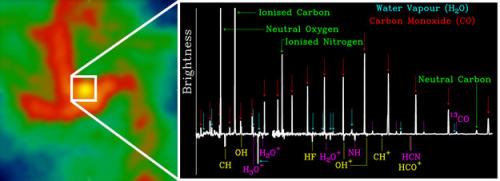

| Visitors Now: | |
| Total Visits: | |
| Total Stories: |

| Story Views | |
| Now: | |
| Last Hour: | |
| Last 24 Hours: | |
| Total: | |
Herschel Finds Hot Gas on Menu for Milky Way’s Supermassive Black Hole – ESA
Tuesday, May 7, 2013 6:55
% of readers think this story is Fact. Add your two cents.
Herschel Finds Hot Gas on Menu for Milky Way’s Supermassive Black Hole – ESA
(Phys.org) —ESA’s Herschel space observatory has made detailed observations of surprisingly hot molecular gas that may be orbiting or falling towards the supermassive black hole lurking at the center of our Milky Way galaxy.
Our local black hole is located in a region known as Sagittarius A*—Sgr A*—after a nearby radio source. It has a mass about four million times that of our Sun and lies around 26,000 light-years away from the solar system.

The environment at the centre of our Milky Way Galaxy. The Galactic Centre hosts a supermassive black hole in the region known as Sagittarius A*, or Sgr A*, with a mass of about four million times that of our Sun. A dense torus of molecular gas and dust surrounds the Galactic Centre and occupies the innermost 15 light-years of our Galaxy. Enshrouded within the disc is a central cavity, with a radius of a few light-years, filled with warm dust and lower density gas.Part of this gas is being heated by the strong ultraviolet radiation from massive stars that closely orbit the central black hole. Heating also likely results from strong shocks, generated as gas orbits around or flows towards Sgr A*, in collisions between gas clouds or in material flowing at high velocity from stars and protostars. Credits: ESA–C. Carreau
Even at that distance, it is a few hundred times closer to us than any other galaxy with an active black hole at its center, making it the ideal natural laboratory to study the environment around these enigmatic objects.
Vast amounts of dust lie in the plane of the Milky Way between here and its center, obscuring our view at visible wavelengths. But at far-infrared wavelengths, it is possible to peer through the dust, affording Herschel’s scientists the chance to study the turbulent innermost region of our galaxy in great detail.

This illustration combines a view obtained at radio wavelengths of ionised gas at the centre of our Galaxy, the Milky Way (left panel), with a spectrum towards the very centre taken with ESA’s Herschel at far-infrared wavelengths (right panel). The spectrum shows the rich variety of molecules that have been detected in this region, which range from carbon monoxide and water vapour to hydrogen cyanide and many light molecules that play a critical role in the chemistry of the interstellar medium. Some of them have been detected for the first time with Herschel. These data show that the molecular gas is surprisingly hot – the temperature estimated from the emission from carbon monoxide reaches up to 1000 ºC. The most likely source of heating of the hot molecular gas are shocks that develop as gas orbits around or flows towards Sagittarius A*, the region hosting the supermassive black hole that lies at the centre of the Milky Way. Copyright Radio-wavelength image: National Radio Astronomy Observatory/Very Large Array (courtesy of C. Lang); spectrum: ESA/Herschel/PACS & SPIRE/J.R. Goicoechea et al. (2013).
Herschel has detected a great variety of simple molecules at the Milky Way’s heart, including carbon monoxide, water vapor and hydrogen cyanide.
By analyzing the signature from these molecules, astronomers have been able to probe some of the fundamental properties of the interstellar gas surrounding the black hole.
“Herschel has resolved the far-infrared emission within just 1 light-year of the black hole, making it possible for the first time at these wavelengths to separate emission due to the central cavity from that of the surrounding dense molecular disc,” says Javier Goicoechea of the Centro de Astrobiología, Spain, and lead author of the paper reporting the results.
The biggest surprise was quite how hot the molecular gas in the innermost central region of the galaxy gets. At least some of it is around 1,000°C, much hotter than typical interstellar clouds, which are usually only a few tens of degrees above the -273°C of absolute zero.
Journal reference: Astrophysical Journal Letters
Provided by European Space Agency
Read more at:


